ACCURACY OF INDIRECT OSCILLOMETRIC BLOOD PRESSURE MEASUREMENT IN ANESTHETIZED
1674 EITHER CAT 26 ACCURACY OF VASCULAR DUPLEX IN38 DRIVE MICROMETER ADJUSTABLE TORQUE WRENCH RATCHET HEAD ACCURACY
44 PRECISION AND ACCURACY WITH CLASSICAL PSYCHOPHYSICAL METHODS A
A HIGHER CRITERION FOR ACCURACY LEVELS L Z
ACCURACY AND FLUENCY ACCURACY AND FLUENCY ACCURACY
ACCURACY AND PRECISION INTRODUCTION MASS AND VOLUME ARE EXTRINSIC
Blood pressure measurements in foals
Accuracy of indirect oscillometric blood pressure measurement in anesthetized neonatal foals
A diagnostic study
And
Course of blood pressure in neonatal foals
A short literature study
D.J.J. van den Broek
Research Internship article
Supervisor: Dr. I.D. Wijnberg
August 2013
Table of contents
Table of contents……………………………………………………………………………………………………………………1
Accuracy of indirect oscillometric blood pressure measurement in anesthetized foals
……….………2-14
Abstract………………………………………………………………………………………………………………………………….2
Introduction……………………………………………………………………………………………………………………….2-3
Material and Method………………………………………………………………………………………………………….4-5
Results………………………………………………………………………………………………………………………………5-11
Discussion………………………………………………………………………………………………………………………12-13
Literature……………………………………………………………………………………………………………………….13-14
Course of blood pressure in neonatal foals………………………………………………………………….15-16
Accuracy of indirect oscillometric blood pressure measurement in anesthetized neonatal foals
D.J.J. van den Broek, Faculty of Veterinary Medicine, Utrecht University
Abstract
To obtain the arterial blood pressure in horses several techniques and devices can be used. Every technique and device having its own advantages and disadvantages. In this study the Microlife BP A100 Plus with Philips cuff M1872B size 4 is being analyzed. As participants on this study we used foals which were undergoing surgery or were staying in the intensive care unit. The foals undergoing surgery participated in the part of the study that analyses the accuracy of the blood pressure device. The foals staying in the intensive care unit participated in the part of the study
that intended to investigate the blood pressure varieties in critical care foals during the day. Statistical analysis revealed the device to be inaccurate for blood pressure measurements. There seems to be an overestimation of the systolic and diastolic pressure with a low accuracy and a low repeatability. However, for measuring the heart frequency (pulse rate) the device seems to be both accurate and a precise in anesthetized foals. The data collected from the foals in the intensive care unit was not further analyzed due to the performance of the device. The advice of the authors is not to use the Microlife BPA 100 plus oscillometric blood pressure device in combination with the Philips M1872B #4 cuff to obtain blood pressure values in foals.
Introduction
The peripheral arterial blood pressure can be measured directly by intra-arterial catheterization or indirectly by placement of an inflatable cuff. The advantage of direct blood pressure measurement are the close relationship to the actual central arterial pressure and the possibility of continuous monitoring. However a risk is involved during repositioning or restraint of foals since it might be a port d’entrée for infection or a cause of thrombus formation (Corley, 2002; Franco et al., 1986; Taylor, 1981).
Indirect blood pressure is measured in a non-invasive manner using an inflatable cuff and a device for the detection of the peripheral pulse. The cuff is inflated up to a pressure greater than the systolic pressure and then gradually deflated. Detection of the peripheral pulse waves together with measurement of pneumatic cuff pressure gives an estimation of the peripheral blood pressure. Indirect blood pressure measurement is non-invasive and easy applicable, although careful positioning of the cuff is necessary and continuous monitoring is not an option (Geddes, 1977).
Several techniques of indirect blood pressure measurement in the horse are described in literature; mostly these techniques differ in their method to record the return of pulsatile flow. Methods depend on auscultation, palpation or Doppler technique (Brown & Holmes, 1981; Taylor, 1981).
The middle coccygeal artery is most commonly used to measure indirect blood pressure measurement and seems to have the most accurate agreement with the arterial pressure, but the dorsal metatarsal artery can also be used (Giguère et al., 2005; Parry et al., 1982; Covington & McNutt, 1931).
The auscultatory techniques are suitable for the measurement of changes in systolic pressure and reflect these changes accurately. But the method is subjective, sensitive to external motion and sometimes fails to detect Korotkoff sounds (thumping sounds being heard when the pressure in the cuff is between the systolic and diastolic pressure) (Riebold & Evans, 1985; Muir et al., 1983; Ellis, 1975).
Oscillometric techniques are based on palpation of pulse waves and are not affected by motion, bumping or extraneous noise. Changes in mean, systolic and diastolic pressures are reflected accurately, but the blood pressure values are lower than directly obtained pressure values. ( Nout et al., 2002) Nevertheless, the measurements of mean and diastolic pressure are useful due to a good correlation between directly and indirectly obtained blood pressure values. In foals the level of agreement of the systolic pressure was insufficient (Nout et al., 2002; Holdstock et al., 1998; Branson, 1997; Franco et al., 1986; Riebold & Evans, 1985; Muir et al., 1983).
Methods using the Doppler technique for detection of the pulse disclose a close relationship to true values obtained by direct measurement. One study reports that this method is not acceptable for use in anesthetized dorsally recumbent horses, because 5% of measurements obtained by Doppler have an error rate greater than 20.2 mmHg (Bailey et al., 1994; Latshaw et al., 1979; Gay et al., 1977).
In general, the indirect methods tend to underestimate intra-arterial pressure (Branson, 1997; Franco et al., 1986; Ellis, 1975; Glen, 1972) although some investigators claim the indirect method to overestimate systolic pressure (Riebold & Evans, 1985).
As mentioned above, the middle coccygeal artery is generally used for indirect blood pressure measurement. The cuff should be carefully placed tight at the base of the tail. Clipping the hair of the tail is not necessary (Corley, 2002; Parry et al., 1982).
The accuracy of the measurement is influenced by the bladder width. A width of about one-fifth to one-quarter of the member circumference seems optimal (Latshaw et al., 1979;) . Blood pressure is underestimated by 5% using a bladder width of 30% of member circumference (circumference of the limb or tail) and a 5% overestimation occurs using a bladder with a width of 20% of the member circumference (Latshaw et al., 1979; Geddes et al., 1977). A bladder width/tail girth ratio of 0.482 underestimates the systolic pressure and overestimates the diastolic pressure both by 8.8% (Parry et al., 1982).
In foals the oscillometric technique with a cuff around the middle coccygeal artery is most frequently described. There seems to be a good correlation between indirectly and directly measured values, but the indirectly obtained values are constantly lower. Indirect blood pressure measurement by placing an inflatable cuff seems to be an acceptable method for measuring at least the mean arterial pressure in foals (Giguère et al., 2005; Nout et al., 2002; Franco et al., 1986).
In this research we will study the accuracy of the Microlife BP A100 Plus with Philips cuff M1872B size 4, an indirect blood measurement device.
Material and Method
Intensive care indirect measurements.
Design: Diagnostic study
Participants: Neonatal foals up to 3 months of age brought to the Intensive care unit of the Equine University Clinic of the faculty of Veterinary Medicine, Utrecht, NL during the period of 01-03-11 t/m 31-05-11. Eight foals, male and female, participated in this study.
Equipment:
Blood pressure monitoring device (Microlife BP A100 Plus with Philips cuff M1872B size 4)
Data collection:
For faculty staff and students an instruction form was made in order to keep the measuring method constant.
Foals staying in the intensive care unit were measured every two hours during 24 hours. The blood pressure was measured with the indirect method using the Microlife device.
The cuff was placed around the base of the tail in order to measure the pressure of the middle coccygeal artery. (Corley, 2002; Giguere, 2005)
To reduce the influences of the position of the foal on the pressure, all the foals were measured lying down while taking into account the vertical relation to the heart. (Corley,2002)
Every measuring point consisted of three measurements within three minutes. Time, systolic pressure, diastolic pressure and pulse frequency were recorded. (Corley, 2002)
During the measurements with the Microlife device the heart frequency was measured by auscultation of the heart or palpation of the ictus cordis. Pulse frequency (heart rate), body temperature and breathing rate were documented . (Corley, 2002)
Direct vs indirect measurements.
Design: Diagnostic study
Participants: Neonatal foals till 3 months of age brought to the Equine University Clinic of the faculty of Veterinary Medicine, Utrecht, NL and undergoing intestinal surgery during the period of 01-03-11 t/m 31-05-11. Five foals participated in this study
Equipment:
A Blood pressure monitoring device; Microlife BP A100 Plus with Philips cuff M1872B size 4 was used to measure the blood pressure indirectly.
A 20G catheter was placed intravenously directly after the foals were anesthetized, and a BD DTX plus pressure transducer in combination with a datex-ohmeda S5 monitor was used to record the intra arterial blood pressure.
Data collection:
The blood pressure of foals that were under anesthesia was measured every five minutes during the entire duration of the surgery. The cuff around the base of the tail was placed at the moment the foal was under anesthesia and lying on its back on the operating table.
Methods employed were the indirect measurement with the Microlife device and Philips cuff around the base of the tail and direct measurement with intra arterial catherization of the a. facialis with a 20G catheter. The catheter was attached to an electronic pressure transducer (BD DTX plus pressure transducer) which was zeroed and placed at the level of the sternal manubrium. The electronic pressure device was joined to a monitor (datex-ohmeda S5 monitor) which displayed the systolic pressure, diastolic pressure and the pulse rate. (Nout, 2002; Corley, 2002; Giguere, 2005)
Measuring points were every five minutes. During these measuring points the blood pressure values were noted for the indirect device and at the same time the direct values were obtained from the monitor. Systolic pressure, diastolic pressure and pulse rate were documented in a time table. All data collected was pooled in one group. (Nout, 2002; Giguere, 2005)
Statistical analysis:
To investigate the accuracy and precision of our indirect blood pressure device, the Microlife BP A100 Plus with Philips cuff M1872B size 4, in comparison to the direct method, the following statistical analyses were made. The bias (mean difference between directly and indirectly obtained measurements) was calculated to investigate the accuracy of the device. A paired sample t test was used to reveal if the difference between the values obtained by the direct and indirect method was statistically significant, meaning the device to be inaccurate. The confidence interval was set at 95%. The limits of agreement (d-2SD and d+2SD) were calculated to investigate if the device, obtains precise blood pressure values. Bland Altman plots were made to investigate if there is any systematic difference between the obtained measurements. Bland-Altman plots are used to assess the agreement among two different methods that measure the same parameter. In these plots the x-axis is assigned to the mean of every measurement (direct – indirect)/2 and the y-axis is assigned to the difference between every measurement (direct – indirect). If there is a systematic difference between the direct and indirect method, for example one of the methods gives results that are considered to be too high, all of the dots in the plot will be located above or below the zero line. If the dots are scattered in the plot it means that there is no consistent bias. The lines in the plot indicate the mean difference (solid line), or mean bias, and the limits of agreement (dashed lines). The closer the limits of agreement lines get, the closer the correlation between the two types of measurement. The closer the line of the mean difference is to zero, the more similar the measurements are. (Vocht de, 2012)
Table 1. Mean and standard deviation of the direct and indirect measurements of blood pressure.
|
|
Measurement |
N |
Mean |
SD |
|
Systolic |
direct |
56 |
66,54 |
13,280 |
|
indirect |
56 |
89,91 |
15,965 |
|
|
Diastolic |
direct |
56 |
40,13 |
6,742 |
|
indirect |
56 |
51,75 |
13,275 |
|
|
Mean pressure |
direct |
56 |
39,670 |
24,8269 |
|
indirect |
56 |
70,830 |
13,6486 |
|
Pulse rate |
direct |
56 |
103,38 |
14,398 |
|
indirect |
56 |
102,73 |
14,643 |
Table 1 shows the mean values of the systolic, diastolic, mean pressure and pulse rate for both the direct and indirect measurements. Also the standard deviation (SD) is given which shows how much variation exists from the average. N shows the number of valid observations.
Results
The data collected from the foals undergoing surgery were pooled in one group since they were similarly attached to both the direct blood pressure device as well as the indirect blood pressure device. This meaning; if the two devices both work properly they would measure the same blood pressure. The group consisted 5 foals. However, the indirect method failed in one of these foals. The direct method failed in two foals. Leaving two foals to participate this research. The indirect and direct method failed in three foals due to incapability to place the cuff or intra-arterial catheter. The duration of the surgeries were about 155 and 215 minutes. Fifty-six blood pressure measurements were recorded from two foals which were undergoing surgery. The indirectly obtained blood pressure values were compared with simultaneously measured direct blood pressure values, obtained by catheterization of the facial artery. The blood pressure was obtained by measuring the systolic, diastolic, mean pressure and pulse rate. In table 1 the mean and standard deviations of both the direct and indirect measurements for each are given.
In figure 1 the indirect and direct obtained blood pressure values are plotted for the systolic, diastolic, mean pressure and pulse rate values with the line of equality for reference. The line of equality is where X and Y are exactly the same. Figure 1 a shows the scatterplot for the systolic pressure. The dots are above the line of equality meaning the indirect device to overestimate the systolic pressure. Figure 1 b shows the scatterplot for the diastolic pressure. Most of the dots are above the line of equality, meaning an overestimation of the indirect device. The same goes for the mean pressure in figure 1 c. Figure 1d shows the plot for the pulse rate. The dots are centered around the line of equality, meaning a good correlation between the indirect and the direct device.
From these 56 values the bias (mean difference between directly and indirectly obtained blood pressure values) and limits of agreement (2x the standard deviation of the difference) for systolic, diastolic, mean blood pressure and pulse rate were calculated and are shown in table 2.
Table 2. Bias and limits of agreement for the blood pressure.
|
Descriptive Statistics |
||||
|
|
N |
Mean |
SD |
Limits of agreement |
|
Systolic |
56 |
-23,37 |
12,585 |
-48,54; 1,8 |
|
Diastolic |
56 |
-11,63 |
9,631 |
-30,892; 7,632 |
|
Mean pressure |
56 |
-31,161 |
17,5326 |
-66,2262; 3,9042 |
|
Pulse rate |
56 |
,64 |
5,154 |
-9,668; 10,948 |
In table 2 the mean difference for the systolic, diastolic, mean pressure and pulse rate is given. Also the standard deviation (SD) is given, which shows how much variation exists from the average. The limits of agreement show how much random variation may be influencing the ratings. N shows the number of valid observation.
For the systolic pressure the mean bias is -23.37 ± 12.585 mmHg, with limit of agreements of -48.54 mmHg and 1.8 mmHg. The diastolic and mean pressures have a bias of -11.63 ± 9.631 mmHg and -31.161±17.533 mmHg respectively, with limits of agreement between -30.89 and 7.63 mmHg and -66.23 and 3.90 mmHg, respectively. The pulse rate has a low bias of .64 ± 5.154 beats/min, with limits of agreement between -9.668 beats/min and 10.948 beats/min. Figure 2 shows Bland Altman plots, as described in methods, for the blood pressure values.
A paired sample t-test was used to determine if a significant difference existed between the bias of the systolic, diastolic, mean pressure and pulse rate and is shown in table 3.
Table 3. Paired sample t-test showing the significant difference between the bias.
|
|
Mean |
Std. Deviation |
95% Confidence Interval of the Difference |
t |
df |
Sig. (2-tailed) |
||
|
Lower |
Upper |
|||||||
|
Pair 1 |
Bias systolic |
-23,375 |
12,585 |
-26,745 |
-20,005 |
-13,899 |
55 |
,000 |
|
Pair 2 |
Bias diastolic |
-11,625 |
9,631 |
-14,204 |
-9,046 |
-9,033 |
55 |
,000 |
|
Pair 3 |
Bias mean pressure |
-31,1607 |
17,5326 |
-35,8560 |
-26,4655 |
-13,300 |
55 |
,000 |
|
Pair 4 |
Bias pulse rate |
,643 |
5,154 |
-,737 |
2,023 |
,933 |
55 |
,355 |
Table 3 shows the results of the paired sample t-test for the bias of the systolic, diastolic, mean pressure and pulse rate. The significant difference, mean values and standard deviation are given as well as the 95% confidence interval. To see if the means of the direct en indirect measurements are different the t-value is shown. Degrees of freedom (n-1) are shown in the df queue.
Table 3 shows the results of the paired sample t-test for the bias of the systolic, diastolic, mean pressure and pulse rate. The bias is measured by subtracting the obtained indirect values from the obtained direct values. The mean and standard deviation (SD) are given as well as the lower and upper boundaries of the 95% confidence interval. The significant difference is shown for the bias in the most right queue. To see if the means of the direct en indirect measurements are different the t-value is shown. The closer the t value is to zero, the more the values for direct and indirect coincide.
The paired samples t test reveals a statistically significant difference (Table 3; significant difference = 0,000) between the mean systolic blood pressure measurements obtained by the direct method (Table 1: 66.54±13.280 mmHg) and the indirect method (Table 1: 89.91±15.965 mmHg), Table 3: t(55)=-13.899. Meaning the values for indirect and direct measurements do not coincide. It also shows a statistically significant difference between the bias of the diastolic blood pressure and the mean pressure obtained by the direct method (Table 1: respectively 40.13±6.742 ; 39.670±24.827) and the indirect method (Table 1: respectively 51.75±13.275 ; 70.830±13.649) with respectively Table 3: t(55)=-9.046 and t(55)=-13.300. Meaning the values for indirect and direct measurements do not coincide. The difference between the mean pulse rate obtained by the direct method (Table 1: 103.38±14.398) and indirect method (Table 2: 102.73±14.643) is not found to be significantly different (Table 3: t(55)=0.933). Meaning the values for indirect and direct measurements coincide.
Figure 1: a, b, c, d The mean values of the systolic (a), diastolic(b), mean pressure (c) and pulse rate (d) determined by the indirect device (Y-axis) plotted against the mean values measured by the direct device (X-axis). The line of equality is drawn in for reference.
a) Systolic: direct vs indirect systolic pressure (mmHg)

b) Diastolic: direct vs indirect diastolic pressure (mmHg)
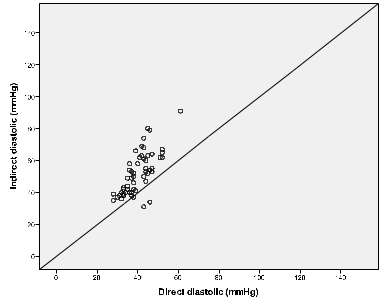
c) Mean pressure: direct vs indirect mean pressure (mmHg)
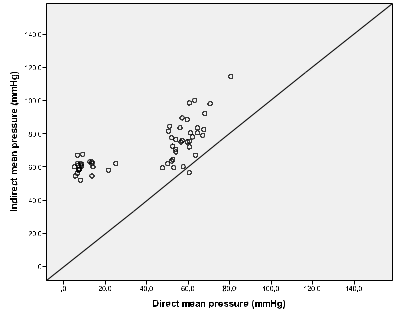
d) Pulse rate: direct vs indirect pulse rate (beats/min)
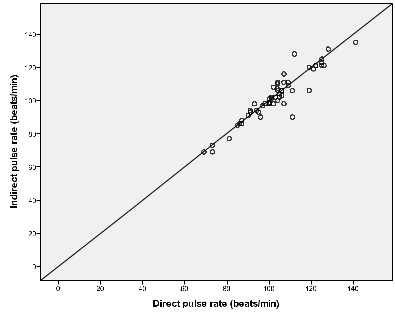
Figure 2: a, b, c, d Bland Altman plots of the mean systolic diastolic, mean pressure and pulse rate values. The bias is calculated by extracting the obtained indirect values from the obtained direct values (Y-axis). The mean values are calculated by adding up the direct and indirect values and dividing them by 2 (X-axis). Solid line: mean difference (mean bias). Dashed lines = limits of agreement; upper: mean difference (mean bias) + 2x SD, lower: mean difference (mean bias) - 2x SD.
a) Bland Altman systolic pressure (mmHG)
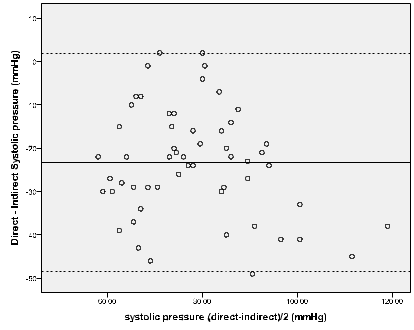
b) Bland Altman diastolic pressure (mmHG)
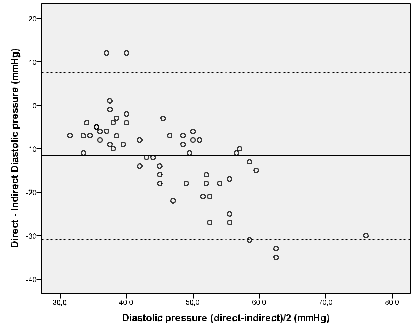
c) Bland Altman mean pressure (mmHG)

d) Bland Altman pulse rate (beats/min)
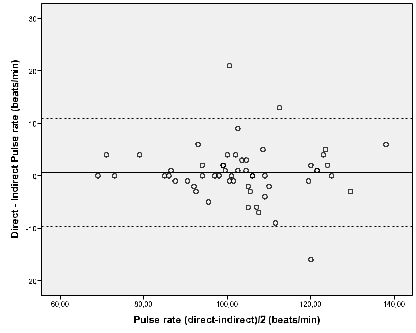
The results from the foals staying in the intensive care unit are not analysed due to poor performance of the device as will be described in the discussion. Therefore it was redundant to put the results together in graphs and figures in this article.
Discussion
In this study we investigated the accuracy and precision of the Microlife BPA 100 plus oscillometric blood pressure device and the Philips M1872B #4 cuff used for indirect blood pressure measurement in foals.
The indirectly obtained blood pressure values were compared with simultaneously measured direct blood pressure values, obtained by catheterization of the facial artery. In total we obtained 56 values from two foals.
From these 56 values we calculated the bias (mean difference between directly and indirectly obtained blood pressure values) and limits of agreement (d-2SD and d+2SD) for systolic, diastolic, mean blood pressure and pulse rate (table 2 in results).
The independent samples t test reveals a statistically significant difference between the mean systolic blood pressure measurements obtained by the direct method and the indirect method. In this study we agree that the direct method is the gold standard, meaning the indirect device to be inaccurate. Fig 1a shows the scatterplot for the systolic pressure. The dots are above the line of equality meaning an overestimation of the blood pressure using the indirect device.
The conclusion is that the device used in this study tends to be inaccurate and overestimating the systolic pressure. In contrast to this finding, other authors state that the indirectly obtained values tend to underestimate systolic pressure (Branson, 1997; Franco et al., 1986; Ellis, 1975; Glen, 1972) and only one other study states that the systolic pressure is overestimated when using the indirect method (Riebold & Evans, 1985). However, their device was based on auscultatory technique and not on oscillometric technique as is used in our device (Riebold & Evans, 1985).
The wide range between the limits of agreement (dashed lines in fig. 2a: bland altman systolic pressure) suggest that this device is not a precise method for measurement of the systolic pressure. The conclusion must be that the Microlife BPA 100 plus oscillometric blood pressure device and the Philips M1872B #4 cuff is not a valid measurement system for systolic pressure in the foal, with both low accuracy and low repeatability. Nout et al. (2002) also found the level of agreement of the systolic pressure to be insufficient when obtained by an indirect oscillometric method in foals.
The device also has a low accuracy for the measurement of diastolic pressure. Although the bias for diastolic pressure is half as high as the bias for systolic pressure, these values still overestimate diastolic pressure significantly (fig 1b). The wide range between the limits of agreement (dashed lines in fig. 2b: bland altman diastolic pressure) suggest that this device is not a precise method for measurement of the diastolic pressure.
The device also has a low accuracy for mean blood pressure and tends to overestimate this value (fig 1 c and fig 2c). The wide range between the limits of agreement (dashed lines in fig. 2c: bland altman mean pressure) suggest that this device is not a precise method for measurement of the mean pressure. The mean bias line (solid line in figure 2 a,b,c) is nowhere near zero and therefore the indirect measurements differ too much from the direct measurements.
As far as the author is aware of, no other authors reports about overestimation of the diastolic blood pressure using an indirect method of blood pressure measurement. Again, the limits of agreement for both diastolic and mean pressures suggest this device to be imprecise with significant difference between obtained values. Earlier reports about the use of an oscillometric technique for diastolic and mean blood pressure measurement in the horse show good correlation and precision, when applied on foals (Giguère et al., 2005; Nout et al., 2002; Holdstock et al., 1998; Branson, 1997; Franco et al., 1986; Riebold & Evans, 1985; Muir et al., 1983).
The bladder width/tail girth ratio is of importance for the accuracy of indirect blood pressure measurement (Parry et al., 1982; Latshaw et al., 1979; Geddes et al., 1977). In our study, this ratio was not calculated. All foals were measured with the same size of cuff. The unusual findings of overestimation of blood pressure by the indirect method in our study could possibly be explained by using a cuff with an unfitting bladder width (Geddes et al., 1977).
Although the described device does not seem to be a valid system for blood pressure measurement in foals, it seems to be both an accurate and a precise method for measurement of the pulse rate in anesthetized foals. There is no statistically significant difference between the mean measurements of the directly and indirectly obtained pulse rate measurements meaning the device to be accurate for pulse rate. The narrow range between the limits of agreement (dashed lines in fig. 2d: bland altman pulse rate) and the close position to zero of the mean bias (solid line in fig 2d) suggest that this device is a precise method for measuring the pulse rate.
The poor performance of the device as described above makes it abundant to perform statistical analysis on the results obtained from the eight foals in the intensive care unit. Our aim was to investigate the trends in blood pressure during the day. These foals were measured using the indirect device and did not have an intra-arterial catheter and therefore the results cannot be analyzed.
In conclusion, the Microlife BPA 100 plus oscillometric blood pressure device together with the Philips M1872B #4 cuff seems not to be a valid device for blood pressure measurement in anesthetized foals. However, it seems to be both an accurate and a precise device for heart frequency measurement in anesthetized foals. In the future, more measurements should be obtained taking the bladder width/tail girth ratio into account.
There seems to be a good correlation between directly and
indirectly measured values obtained by other oscillometric devices
(Giguère et al., 2005; Nout et al., 2002; Franco et al.,
1986). Hence, the advice of the authors is not to use the Microlife
BPA 100 plus oscillometric blood pressure device in combination with
the Philips M1872B #4 cuff to obtain blood pressure values in
foals.
Literature
Giguere S, Knowles A, Valverde A, Bucki E, Young L. Accuracy of indirect measurement of blood pressure in neonatal foals. J Vet Intern Med 2005; 19:571-576.
Nout YS, Corley KTT, Donaldson LL, Furr MO. Indirect oscillometric and direct blood pressure measurements in anesthetized and conscious neonatal foals. J Vet Emergency and Critical care 2002; 12:75-80.
Corley KTT. Monitoring and treating haemodynamic disturbances in critically ill neonatal foals. Part 1; haemodynamic monitoring. Equine Veterinary Education 2002; 5:270-279.
Covington N.G. & McNutt G.W. Studies of normal blood pressure in animals I: Blood pressure in the horse with brief note on the ox. Journal of the American Veterinary Medical Association 7: 22-26, 1931.
Franco R.M., Ousey J.C., Cash R.S.G., Rossdale P.D. Study of arterial blood pressure in newborn foals using an electronic sphygmomanometer. Equine Veterinary Journal 18: 475-478, 1986.
Glen J.B. Indirect blood pressure measurement in conscious horses. Equine Veterinary Journal 4: 204-208, 1972.
Holdstock N.B., Ousey J.C., Rossdale P.D. Glomerular filtration rate, effective renal plasma flow, blood pressure and pulse rate in the equine neonate during the first 10 days postpartum. Equine Veterinary Journal 30: 335-343, 1998.
Journal of Reproduction and Fertility, Supplement 35: 623-628, 1987.
Bailey J.E., Dunlop C.I., Chapman P.L., Demme W.C., Allen S.L., Heath R.B., Crump K.T., Golden C.S., Wagner A.E. Indirect Doppler ultrasonic measurement of arterial blood pressure results in a large measurement error in dorsally recumbent anaesthetized horses. Equine Veterinary Journal 26: 70-73, 1994.
Branson K.R. A clinical evaluation of an oscillometric blood pressure monitor on anesthetized horses. Journal of Equine Veterinary Science 17: 537-540, 1997.
Brown C.M. & Holmes J.R. A review of some factors which may influence values of indirectly recorded arterial blood pressure in the horse. Journal of Equine Veterinary Science 1:208-211, 1981.
Ellis P.M. The indirect measurement of arterial blood pressure in the horse. Equine Veterinary Journal 7: 22-26, 1975.
Gay C.C., McCarthy M., Reynolds W.T., Carter J. A method for indirect measurement of arterial blood pressure in the horse. Australian Veterinary Journal 53: 163-166, 1977.
Geddes L.A., Chaffee V., Whistler S.J., Bourland J.D., Tacker W.A. Indirect mean blood pressure in the anesthetized pony. American Journal of Veterinary Research 38: 2055-2057, 1977.
Latshaw H., Fessler J.F., Whistler S.J., Geddes L.A. Indirect measurement of mean blood pressure in the normotensive and hypotensive horse. Equine Veterinary Journal 11: 191-194, 1979.
Muir W.W., Wade A., Grospitch B. Automatic noninvasive sphygmomanometry in horses. Journal of the American Veterinary Medical Association 182: 1230-1233, 1983.
Parry B.W., McCarthy M.A., Anderson G.A., Gay. C.C. Correct occlusive bladder width for indirect blood pressure measurement in horses. American Journal of Veterinary Research 43: 50-54, 1982.
Riebold T.W. & Evans A.T. Blood pressure measurements in the anesthetized horse: comparison of four methods. Veterinary Surgery 14: 332-337, 1985.
Taylor P.M. Techniques and clinical application of arterial blood pressure measurements in the horse. Equine Veterinary Journal 13: 271-275, 1981.
Vocht de, A. SPSS20 IBM SPSS statistics, 2012
Course of blood pressure in neonatal foals
D.J.J. van den Broek, Faculty of Veterinary Medicine, Utrecht University
In equine pregnancy the fetal arterial blood pressure increases towards term. Increasing vasopressinergic and noradrenergic influences, and changes in oxygen metabolism contribute to the rise of the fetal arterial blood pressure (Giussani et al., 2005). Within the first 24 hours of life rapid changes occur in the circulation of the normal foal. A few hours after birth the mean systemic arterial pressure of the neonate is >80 mmHg and in the next two weeks this value increases to 100 mmHg (Thomas et al., 1987). Franco et al. (1986) report blood pressure values in the first 3 days of life that are substantially higher;144 and 74 mmHg on day 1 to 154.5 and 80 mmHg on day 3 postpartum for the systolic and diastolic pressures respectively. Others report about an increase in blood pressure during the first 3 days of age and unchanged values in the following 7 days (Holdstock et al., 1998). In pony foals, a rapid increase in blood pressure is seen in the first month. The systolic and diastolic pressure increase respectively, from 81 and 35 mmHg on day one, to 100 and 41 mmHg on 7 days of age to 111 and 57 mmHg on 3 months of age. On 3 months of age the blood pressure values are still below those in adult horses (Lombard et al., 1984). Interestingly, Piccione et al. (2008) report about a decrease in mean blood pressure during the first 40 days of life, with a mean blood pressure of 105 mmHg on the first day of life to 96.7 mmHg on the 40th day of life. Rhythmicity is lacking in blood pressure of neonatal foals and this leads to the conclusion that blood pressure maturation is absent in foals up to 40 days old (Piccione et al., 2008). Cardiac output increases as foals gain weight, as does the stroke volume with increasing age.
During the first 6 days of life the ductus arteriosus can be patent in normal foals. The systemic vascular resistance declines gradually in the first 14 days of life. The mean pulmonary arterial pressure is about 40 mmHg and within 24 hours this value decreases to about 30 mmHg. The pulmonary vascular resistance also decreases rapidly during this first 24 hours leading to a decrease in blood pressure.(Thomas et al., 1987). There is a decrease of the resting heart rate during the second and third months of life (Lombard et al., 1984). Franco et al. (1986) found a significantly higher blood pressure in thoroughbred foals than in pony foals, but Holdstock et al. (1998) could not reproduce this difference. However they found a marked individual variation in blood pressure within breeds.
In 1931, a weak relationship was noticed between the age of the horse and its blood pressure values (Covington & McNutt, 1931). Later studies report about a strong positive correlation between age and blood pressure in the horse (Östlund et al., 1983). Studies report normal blood pressure values of conscious adult horses to be between 90 to 112 mmHg for the systolic pressure, 40 to 77.3 mmHg for diastolic pressure (Parry et al., 1984; Covington & McNutt, 1931; Schilling, 1919) and a mean arterial pressure of 140 mmHg (Glen, 1972).
Literature
Covington N.G. & McNutt G.W. Studies of normal blood pressure in animals I: Blood pressure in the horse with brief note on the ox. Journal of the American Veterinary Medical Association 7: 22-26, 1931.
Franco R.M., Ousey J.C., Cash R.S.G., Rossdale P.D. Study of arterial blood pressure in newborn foals using an electronic sphygmomanometer. Equine Veterinary Journal 18: 475-478, 1986.
Giussani D.A., Forhead A.J., Fowden A.L. Development of cardiovascular function in the horse fetus. Journal of Physiology 565: 1019-1030, 2005.
Glen J.B. Indirect blood pressure measurement in conscious horses. Equine Veterinary Journal 4: 204-208, 1972.
Holdstock N.B., Ousey J.C., Rossdale P.D. Glomerular filtration rate, effective renal plasma flow, blood pressure and pulse rate in the equine neonate during the first 10 days postpartum. Equine Veterinary Journal 30: 335-343, 1998.
Lombard C.W., Evans M., Martin L., Tehrani J. Blood pressure, electrocardiogram and echocardiogram measurements in the growing pony foal. Equine Veterinary Journal 16: 342-347, 1984.
Östlund C., Pero R.W., Olsson B. Reproducibility and the influence of age on interspecimen determinations of blood pressure in the horse. Comparative Biochemistry and Physiology 74A: 11-20, 1983.
Parry B.W., McCarthy M.A., Anderson G.A. Survey of resting blood pressure values in clinically normal horses. Equine Veterinary Journal 16: 53-58, 1984.
Piccione G., Assenza A., Fazio F., Giannetto C., Caola G. Chronobiologic blood pressure assessment: maturation of the daily rhythm in newborn foals. Biological Research 41: 51-57, 2008.
Schilling S. The blood pressure of the horse. Journal of the American Veterinary Medical Association 55: 401-416, 1919.
Thomas W.P., Madigan J.E., Backus K.Q., Powell W.E. Systemic and pulmonary haemodynamics in normal neonatal foals. Journal of Reproduction and Fertility, Supplement 35: 623-628, 1987.


ACCURACY AND PRECISION OF THE HANDHELD MAVIS WOUND MEASUREMENT
ACCURACY AND PRECISION WORKSHEET ANSWER KEY QUESTIONS 26 2)
ACCURACY CONTROL CHARTS A CCURACY DEFINED THE DEGREE OF
Tags: accuracy of, l. accuracy, pressure, blood, oscillometric, accuracy, indirect, measurement, anesthetized
- AMCPWGF7 WP61 AERONAUTICAL MOBILE COMMUNICATIONS PANEL (AMCP) WORKING GROUP
- ACTA DE LA SESION EXTRAORDINARIA CELEBRADA POR EL PLENO
- WNIOSEK O OKREŚLENIE WARUNKÓW PRZYŁĄCZENIA DO SYSTEMU DYSTRYBUCYJNEGO PALIWA
- COVERAGE REQUEST OF BORROWED ITEMS UNIVERSITY OF WISCONSIN –
- PRODROP AND PRONOMINAL SUBJECTS REANALYZING FEATURES IN THE HISTORY
- UNIT 10 SAVINGS ACCOUNTS NOTES QUIZ DATE TEST DATE
- MEMORIA DEL CURSO ACADÉMICO 20052006 LA ACTIVIDAD REGULAR DE
- SOBRE ÚNICO DECLARACIÓN RESPONSABLE Y OFERTA DE CRITERIOS VALORABLES
- 100 YEARS CELEBRATION TENT OF NATIONS 1916 2016
- MINISTARSTVO ZAŠTITE OKOLIŠA PROSTORNOG UREĐENJA I GRADITELJSTVA 3278 NA
- O REGON FALLEN FIRE FIGHTERS MEMORIAL DONATION FORM 727
- EUROS OSIGURANJE AD 78000 BANJA LUKA BULEVAR SRPSKE VOJSKE
- DESCARGAR EL ARCHIVO ADJUNTO ORIGINAL METRICA ESPAÑOLA 1 EL
- NOT PROTECTIVELY MARKED MAKING A COMPLAINT AGAINST THE POLICE
- VEKÂLETNAME BİLGİLERİ AVDRKADIR GÜNDOĞAN ANKARA BAROSU SICIL NO 13512
- GUIDELINES FOR CANDIDATE FORUMS THE PURPOSE OF FORUMS IS
- CBD CONVENTION ON BIOLOGICAL DIVERSITY DISTR GENERAL UNEPCBDWSCBLAC1INF5 16
- DECLARACION JURADA ARTICULOS 9º Y 10º LEY 19287 Nº
- UD CONOZCO LOS ECOSISTEMAS CON “EL REY LEÓN” JOSÉ
- OFERTAS DE EMPLEO ACTUALIZADAS A DÍA 231013 PARA ACCEDER
- METODOLOGÍA (INSTRUMENTACIÓN OBSERVACIÓN CÁLCULO) 2 METODOLOGÍA (INSTRUMENTACIÓN OBSERVACIÓN CÁLCULO)
- BELOW PLEASE FIND THE CONFERENCING INFORMATION YOU REQUESTED ACCESS
- SECTOR S P O R T PROGRAME PROIECTE
- RISKCITY CASE STUDY EARTHQUAKE RISK ASSESSMENT E EXPECTED TIME
- LISTA DE UTILES ESCOLARES CICLO ESCOLAR 20192020 PREESCOLAR
- ELIZABETH CUTTER LESSON PLAN METHODS OF ELEMENTARY TEACHING SOC
- ANA TERESA TORRES ESPÍRITU INDOMABLE DE LA LITERATURA VENEZOLANA
- (PRIIMEK IN IME OZIROMA NAZIV PRAVNE OSEBE) –
- FCLASS MIDRAGE VARŽYBOS BTŠA ČEMPIONATO III ETAPAS VARŽYBŲ NUOSTATAI
- NZQA UNIT STANDARD 12383 VERSION 8 PAGE 2 OF
 SURAT REKOMENDASI (REFEREE’S REPORT) SURAT REKOMENDASI INI HENDAKLAH DIISI
SURAT REKOMENDASI (REFEREE’S REPORT) SURAT REKOMENDASI INI HENDAKLAH DIISI S ERVIÇO PÚBLICO FEDERAL MJ DEPARTAMENTO DE POLÍCIA
S ERVIÇO PÚBLICO FEDERAL MJ DEPARTAMENTO DE POLÍCIA PROBLEMAS DE PROBABILIDAD DE LA COMPETICIÓN AMC 8 1
PROBLEMAS DE PROBABILIDAD DE LA COMPETICIÓN AMC 8 1 KOTĚROVO CENTRUM ARCHITEKTURY OPS TRMALOVA VILA VYDAVATELSTVÍ FOIBOS
KOTĚROVO CENTRUM ARCHITEKTURY OPS TRMALOVA VILA VYDAVATELSTVÍ FOIBOSBLACKBOARD AND THE TEACH ACT HTTPWWWALAORGALAWASHOFFWOISSUESCOPYRIGHTBDISTANCEEDTEACHACTBESTHTM SPECIFIC TECHNOLOGICAL
 T C DOKUZ EYLÜL ÜNİVERSİTESİ SAĞLIK BİLİMLERİ ENSTİTÜSÜ
T C DOKUZ EYLÜL ÜNİVERSİTESİ SAĞLIK BİLİMLERİ ENSTİTÜSÜERNEST BLOCH SCHELOMO HEBRAIC RHAPSODY FOR VIOLONCELLO SOLO AND
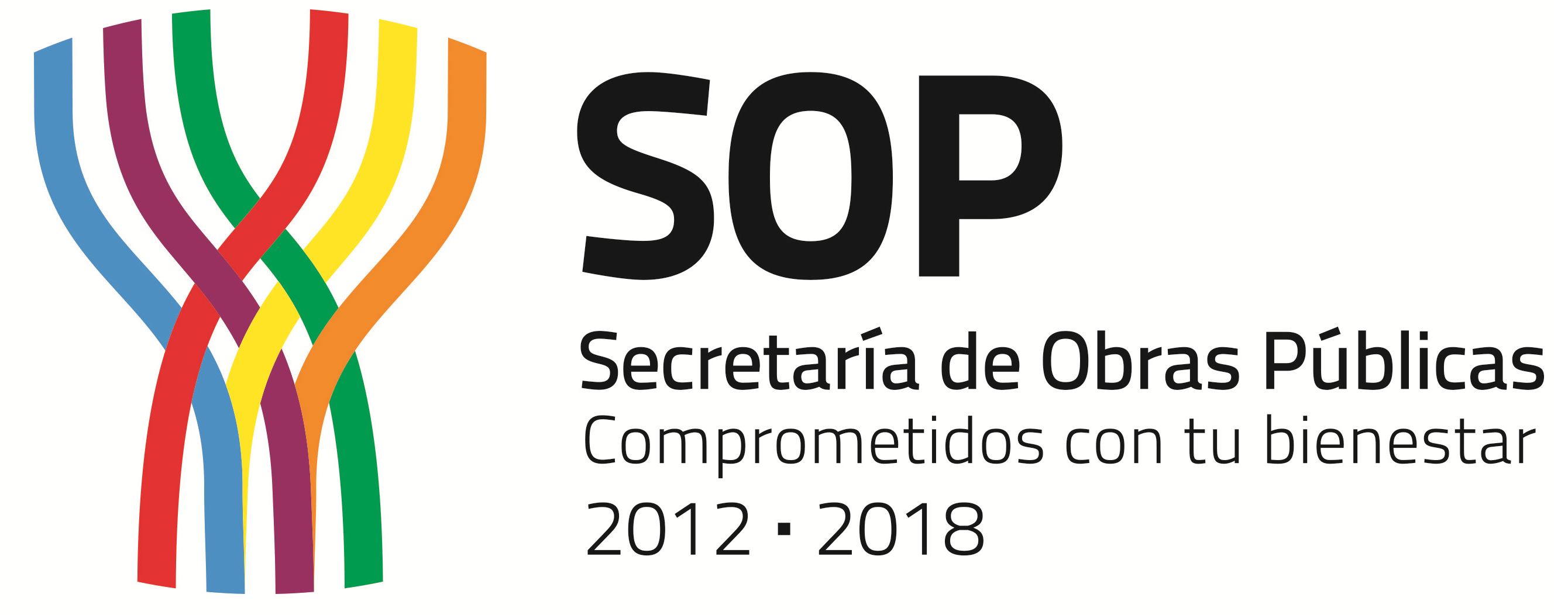 S OPJURF 02 PLIEGO DE REQUISITOS PARA LA INSCRIPCIÓN
S OPJURF 02 PLIEGO DE REQUISITOS PARA LA INSCRIPCIÓN D IRECCIÓN DE BIBLIOTECAS ARCHIVOS Y MUSEOS SUBDIRECCIÓN DE
D IRECCIÓN DE BIBLIOTECAS ARCHIVOS Y MUSEOS SUBDIRECCIÓN DEPROGRAMA DE GEOGRAFÍA DE LA INDUSTRIA (RESUMEN DE LA
VERIFICATION REPORT 3 SCHOOL AGE STUDENTS BY DISABILITY AND
ROBERT A JAKOBSON 15629 73RD AVE SE SNOHOMISH
DAŽNIAUSIAI UŽDUODAMI KLAUSIMAI (FAQ) – FORMA B BENDROS PRAŠYMO
RESULTATS DES 3 COURSES INTERNATIONALES DE CHEVAUX PUR SANG
VIENTO SUR TROMBONES PRESENTACIÓN EN EL CONSERVATORIO DE LA
 UNEPEA1INF10 ADVANCE COPY UNITED NATIONS EP UNEPEA1INF10 UNITED NATIONS
UNEPEA1INF10 ADVANCE COPY UNITED NATIONS EP UNEPEA1INF10 UNITED NATIONSSYLABUS ROK AKADEMICKI 20202021 NAZWA PRZEDMIOTUMODUŁU NANOSTOMATOLOGIA NAZWA JEDNOSTKIEK
GARAND – LISTA DE DIÁLOGOS ESPAÑOL FERNANDO O
 PROFILE OF MEMBERS OF PATIENT REFERENCE GROUP THERE ARE
PROFILE OF MEMBERS OF PATIENT REFERENCE GROUP THERE ARETitle Eating at the Kings Table Bible Book Selected